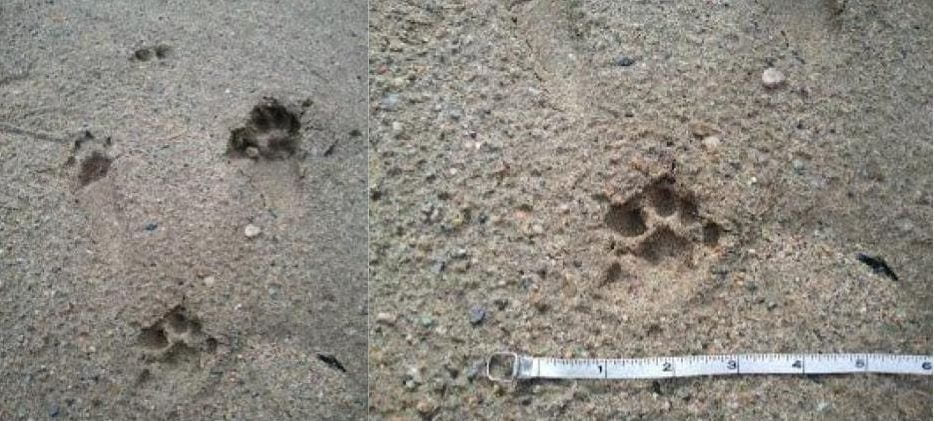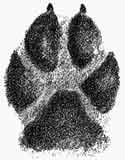
It occurred to me while I was introducing my tracking workshop last week, that tracking is a perfect example of practicing mindfulness. To really learn about any sign that animals leave behind – tracks, scat, nests, cache sites, etc. – you have to take in the whole story, not just the specifics of your find. And like any mindful practice, it takes time and attention, requiring you to bring your full self to the story that is laid out in front of you.
The beautiful thing about practicing mindful observations in the natural world is that all you have to do is look – truly look. It really doesn’t matter if you know the name of that flower that captivated you, or exactly what animal left that track behind. If knowing the specifics are important to you, you will have collected enough information about your find through your mindful observations, that looking up the answers afterward will be straightforward. What’s most important is to take in as much about your find and what’s around it as you can.
Here’s a simple practice that you can try in any natural space, regardless of size. Remember, no experience with tracking or identifying plants/animals/birds is necessary. In fact, the less you know, the more you might observe. Being able to name or label something can often cause us to look past it more quickly. But not knowing sparks our curiosity. Let your curiosity lead you as you examine whatever you’ve found.

I’ll use tracking as our example activity, but the process of mindful observation can be used with anything in nature that you wish to study closely. For studying outdoors you might want to bring paper and pencil for sketching or writing out details, a measuring tape (soft, not rigid), and a phone with a camera or just a camera for recording your finds, if you want. And of course, dress for the weather.
Step 1. Now that you’ve found some tracks (or other nifty natural finds) to observe, take a moment to close your eyes and take three deep, settling breaths. Relax, and work on bringing your attention wholly to the present. At times, when you find that your mind wanders during your observations, gently (it’s important to be kind with your redirection – positive reinforcement, instead of negative will make this practice come easier) bring your focus back to your present work.
Step 2. Start with observing the basics of your find. How big are the tracks? Use your hand as a relative measure if you don’t have a measuring tape. What shape does each foot make (if tracks are clear enough), and what shape does the trail take? Are the feet side-by-side or in a straight line or a curved pattern? How much of the trail can you see? Backtrack it some, if possible.
Studying the shape of the overall trail tells you how this animal is moving: walking, hopping, bounding, trotting or galloping. The animal’s gait can be an identifying clue: squirrels mostly move in a bounding pattern, while wild canines and felines might walk, trot or gallop.
Step 3. Now that we’ve observed the basics, it’s time to hone in on the details. How far apart are the footprints from each other? If you want to identify these to species (which isn’t necessary but makes some of us happy), measure (with your hand or measuring tape) the straddle (width) of the tracks from the outside of one side to the outside of the other, and the stride (length) from the back of the heel to the back of the next in front. This can tell you more about how big the animal might be.
Step 4. Zoom out and connect your animal to the landscape – natural or human-made. How is this animal interacting with its environment? Is it avoiding human-made structures? Avoiding deep snow? Are there other tracks nearby, possibly intersecting with this one? Does the trail cross different habitats (yard, forest, etc.), or stick to one? What time of year is it, and in general, what’s happing in the natural world? Does this animal’s behavior relate to what you think it should be doing?
Step 5. Contemplate what have you discerned about your animal tracks and trail. You’ve studied how large the animal may be, how it seems to be moving, and where it came from and/or went towards. You’ve stepped back and considered the animal in its larger environment. It’s tempting to call it a day at this point and move on, but not just yet. Take a few more minutes to keep studying the landscape, while you piece this animal’s story together. How close to the facts you are with this story is unimportant. The important part here is weaving your observations together into a whole. What story is the natural world telling you? Are you hearing this story from your head (conscious thought), or your heart/gut (subconscious, intuition)?
Your story may be of a mother opossum, out at night looking for food for her babies. Or of a red fox on the scent of a potential mate. Processing your experiences on a conscious and subconscious level through story is a powerful way to solidify your experiences and learn from them. This process builds our ability to listen to our intuition – that part of us that knows things on an energetic level.
Mindfulness takes practice, no matter your environment. The more you practice, the easier it becomes and the more you see and experience. And there’s never a lack of fascinating experiences awaiting you in the natural world.
Happy tracking!

